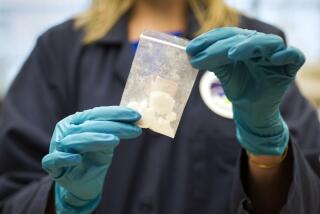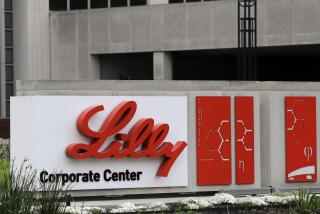Counterfeits Compromise U.S. Drug Supply
- Share via
BALTIMORE — For two months after emergency surgery to replace a diseased liver, Timothy Fagan lived a nightmare, injecting weekly a drug that was supposed to help him heal.
Several hours after each shot, his muscles would cramp so violently that he often limped for days. Doctors assumed Fagan, 16, just wasn’t responding to the medicine meant to boost his red blood cells. Fagan and his parents thought the cramps were a side effect of the drug, Epogen.
Fagan discovered he was the victim of fraud when a subsidiary of the CVS pharmacy chain told him it had received a federal alert about counterfeit Epogen. A check of the labeling on the packages he had been shipped indicated they were fake.
Fagan said the drug’s manufacturer, Amgen, later told him the counterfeit contained only a fraction of the listed drug content.
Two years later, the mystery lingers: Food and Drug Administration officials confirm they’re investigating, but Fagan still doesn’t know how he wound up with the counterfeit drugs.
“Every time I take a ... pill, I still wonder, ‘Is this stuff counterfeit?’ ” said Fagan, now a student at Iona College in New Rochelle, N.Y. “It always runs on your mind. It’s horrible.”
Fagan -- who filed a lawsuit in August 2003 against Amgen, CVS and its subsidiary, and the drug’s distributor -- was the victim of a lucrative and dangerous counterfeit drug trade finding its way into America’s pharmacies and medicine cabinets.
The federal government urged manufacturers in February to consider using new technology -- which includes tiny hidden transmitters and baked-in chemical “fingerprints” -- and researchers say some new ID tricks will be in products this year.
But despite the promise of high-tech developments, experts say counterfeiters have never had it better, thanks in part to gaps in the distribution system and more people buying increasingly expensive drugs over the Internet and abroad.
“For folks who are into crime and counterfeiting, prescription drugs are the new gold fields,” said James Polli, a University of Maryland pharmacy-school researcher who helped develop a “fingerprinting” system. “Smart, talented, well-funded people are putting a lot of effort into making products that look authentic. This is not about some guys with a bathtub full of chemicals in their garage.”
It’s estimated that fewer than 1% of drugs in this country are fake. But FDA officials say they’re seeing larger volumes of counterfeits and better organized operations. Federal counterfeit drug investigations have risen from five a year through the late 1990s to 22 last year, said William Hubbard, an associate FDA commissioner.
Hubbard said some officials estimate it’s more profitable to fake a prescription drug than to import cocaine or heroin.
The FDA worries the problem will only get worse as more people travel abroad or visit Internet sites -- some of which buy medicines in countries with drug stocks rife with counterfeits -- to fill prescriptions that can cost hundreds of dollars per dose.
Counterfeiters are also becoming more adept at insinuating their fakes into the massive U.S. distribution system, where billions of drug doses -- in an array of packages, shapes and prices -- flow from manufacturers to distributors to pharmacists to patients.
Officials say ensuring the system’s integrity will prove daunting.
Three national distributors -- AmerisourceBergen, McKesson and Cardinal Health -- supply the majority of prescription drugs that reach U.S. retail pharmacies. Those companies say that between 97% and 99% of their product comes directly from the manufacturer; the remainder is supplied by thousands of other U.S. wholesalers -- estimates vary from 7,000 to 30,000.
“The question is, where do those [other] wholesalers get their products?” said Frank Palumbo, executive director of the University of Maryland’s Center on Drugs and Public Policy. “We just don’t know.”
The problem, experts say, is that federal and state agencies share the burden of regulating drugs. In a state with lax policies, it’s easier for a distributor to get a license. No national regulation exists to trace the path that any particular drug takes from manufacturer to pharmacy, said Lew Kontnik, an author and security consultant for pharmaceutical companies.
In February, the National Assn. of Boards of Pharmacy created model rules that could be used by states to tighten regulations governing distributors’ licensing. But the FDA, in its much-anticipated February report, said it won’t order drug companies to adopt security measures to combat fraud. Instead, it will ask the industry to come up with its own technology plan.
The result has led to drug companies, distributors and government officials scrambling to evaluate and implement new technologies and security measures.
“It’s not like ... there’s a grand plan. It’s more of a gold rush, a mob rushing in. There are all these different people doing all these different things,” Kontnik said.
Companies in general are reluctant to talk specifically about anti-fraud measures, as counterfeiters have been known to mimic technological advancements in as little as eight months after first seeing them, said Alan Goldhammer, associate vice president of regulatory affairs for the Pharmaceutical Research and Manufacturers of America.
The new technology includes holograms and color-shifting ink, similar to what’s used on the new $20 bills, and barcodes that can be printed directly onto pill surfaces.
The FDA report also highlighted radio frequency identification, or RFID, as a promising safeguard. The technology, similar to what’s used in E-ZPass tollbooth passes, could be implanted in bottles or package labels by 2007, the report said.
But counterfeiting is happening now, cutting into profits and undermining companies’ reputations, Kontnik said.
So while new protections are developed, drug companies are exploring other security options. Eli Lilly & Co., Johnson & Johnson and Pfizer Inc. are among the companies that require distributors to buy direct from the manufacturer or authorized distributors.
The FDA report emphasized that “there is no single magic bullet against what is a growing number of sophisticated counterfeiters,” said Ed Sagebiel, a spokesman for Lilly.
His company, for instance, has been using RFIDs, in a small pilot-testing program, and other anti-counterfeiting technology. But it’s also monitoring Internet sites claiming to offer Lilly products and has terminated distribution agreements with five wholesalers who didn’t buy directly from them, Sagebiel said.
Fagan said his counterfeit Epogen was distributed by AmerisourceBergen. Company spokesman Michael Kilpatric declined to comment on Fagan’s case, but said the distributor buys certain drugs at high risk for counterfeiting, including Epogen, only from the manufacturers. The company buys other drugs from about 20 wholesalers in the “secondary market,” he said, and has done inspections and criminal background checks on those distributors for more than two years.
The FDA’s decision not to issue specific orders securing the drug-supply chain has angered some -- including Fagan’s family.
With no clear federal direction, there’s also “a risk of having a proliferation of technology” bogging down pharmacists and distributors who could have to use several different types of equipment to process drugs from different manufacturers, Kontnik said.
But Hubbard said manufacturers will become expert at adopting and refining new technologies as their reputations suffer at the hands of increasingly bold counterfeiters.
“If your profit is large, and your need to protect that income is great, you’re probably going to be willing to invest in it -- particularly if you know that your product is vulnerable,” he said.
More to Read
Sign up for Essential California
The most important California stories and recommendations in your inbox every morning.
You may occasionally receive promotional content from the Los Angeles Times.













